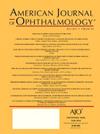Telomere Biology Disorders: Microvascular Abnormalities on Optical Coherence Tomography
IF 4.1
1区 医学
Q1 OPHTHALMOLOGY
引用次数: 0
Abstract
Background and Objective
Telomere biology disorders (TBDs) are inherited conditions caused by telomere dysfunction, impacting systemic and ocular health. We aim to explore the role of optical coherence tomography angiography (OCTA) in identifying retinal microvascular abnormalities in TBDs.
Design
Retrospective case series.
Methods
The electronic medical records of pediatric patients with TBD at a tertiary referral eye center were reviewed from January 2019 to July 2023. OCTA images were reviewed for anomalies of the retinal vasculature.
Results
In total, 13 eyes of 7 patients were included in the study. All patients were genetically confirmed to have TBD. The most common genetic variants were CTC1 (5 patients; 71.4%), ACD (1 patient; 14.3%) and RTEL1 (1 patient; 14.3%). On OCTA, all 13 eyes showed some degree of macular microvascular abnormality in both the SVC and DVC. The most common microvascular abnormality seen in the SVC was blood vessels anastomosis (11; 84.6%), and in the DVC was decreased vessel density (9; 69.2%).
Conclusions
OCTA imaging reveals a high prevalence of microvascular abnormalities in patients with TBD, highlighting its potential role in assessing retinal vascular changes associated with the disease.
端粒生物学紊乱:光学相干断层扫描上的微血管异常。
本文章由计算机程序翻译,如有差异,请以英文原文为准。
求助全文
约1分钟内获得全文
求助全文
来源期刊
CiteScore
9.20
自引率
7.10%
发文量
406
审稿时长
36 days
期刊介绍:
The American Journal of Ophthalmology is a peer-reviewed, scientific publication that welcomes the submission of original, previously unpublished manuscripts directed to ophthalmologists and visual science specialists describing clinical investigations, clinical observations, and clinically relevant laboratory investigations. Published monthly since 1884, the full text of the American Journal of Ophthalmology and supplementary material are also presented online at www.AJO.com and on ScienceDirect.
The American Journal of Ophthalmology publishes Full-Length Articles, Perspectives, Editorials, Correspondences, Books Reports and Announcements. Brief Reports and Case Reports are no longer published. We recommend submitting Brief Reports and Case Reports to our companion publication, the American Journal of Ophthalmology Case Reports.
Manuscripts are accepted with the understanding that they have not been and will not be published elsewhere substantially in any format, and that there are no ethical problems with the content or data collection. Authors may be requested to produce the data upon which the manuscript is based and to answer expeditiously any questions about the manuscript or its authors.

 求助内容:
求助内容: 应助结果提醒方式:
应助结果提醒方式:


